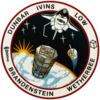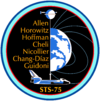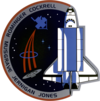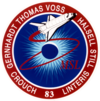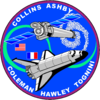Space Shuttle Columbia
| This article needs additional citations for verification. Please help improve this article by adding reliable references. Unsourced material may be challenged and removed. (July 2009) |
| | This article's introduction section may not adequately summarize its contents. To comply with Wikipedia's lead section guidelines, please consider expanding the lead to provide an accessible overview of the article's key points. (April 2009) |
| Columbia OV-102 | |
|---|---|
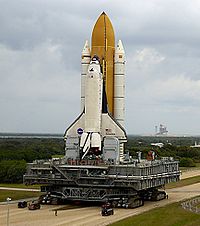 Columbia being transported to launch pad 39A prior to launching on STS-107 | |
| OV designation | OV-102 |
| Country | United States |
| Contract award | July 26, 1972 |
| Named after | Robert Gray’s Columbia Rediviva |
| Status | Destroyed February 1, 2003 |
| First flight | STS-1 April 12, 1981 - April 14, 1981 |
| Last flight | STS-107 January 16, 2003 – February 1, 2003 |
| Number of missions | 28 |
| Crews | 160 |
| Time spent in space | 300 days 17:40:22[1] |
| Number of orbits | 4,808 |
| Distance travelled | 201,497,772 km (125,204,911 miles) |
| Satellites deployed | 8 |
Contents[show] |
[edit] History
Construction began on Columbia in 1975 at Rockwell International's (formerly North American Aviation/North American Rockwell, now Boeing North America) principal assembly facility in Palmdale, California, a suburb of Los Angeles. Columbia was named after the Boston-based sloop ColumbiaRobert Gray, who in the 1790s explored the Pacific Northwest (including going upstream on its namesake river between Washington and Oregon) and which became the first American vessel to circumnavigate the globe. It is also named after the Command Module of Apollo 11, the first manned landing on another celestial body.[2] After construction, the orbiter arrived at Kennedy Space Center on March 25, 1979, to prepare for its first launch. On March 19, 1981, during preparations for a ground test, two workers were asphyxiated while working in Columbia's nitrogen-purged aft engine compartment, resulting in their deaths.[3] captained byThe first flight of Columbia (STS-1) was commanded by John Young, a Gemini and Apollo veteran who was the ninth person to walk on the Moon in 1972, and piloted by Robert Crippen, a rookie astronaut originally selected to fly on the military's Manned Orbital Laboratory (MOL) spacecraft, but transferred to NASA after its cancellation, and served as a support crew member for the Skylab and Apollo-Soyuz missions.
Columbia was successfully launched on April 12,1981, the 20th anniversary of the first human spaceflightVostok 1), and returned on April 14, 1981, after orbiting the Earth 36 times, landing on the dry lakebed runway at Edwards Air Force Base in California. Columbia then undertook three further research missions to test its technical characteristics and performance. Its first operational mission, with a four-man crew, was STS-5, which launched on November 11, 1982. At this point Columbia was joined by Challenger, which performed the next three shuttle missions, while Columbia underwent modifications for the first Spacelab ( mission.

Columbia returned to space on January 12, 1986, with the launch of STS-61-C. The mission's crew included Dr. Franklin Chang-Diaz, as well as the first sitting member of the House of Representatives to venture into space, Bill Nelson.
The next shuttle mission was undertaken by Challenger. It was launched on January 28, 1986, ten days after STS-61-C had landed. The mission ended in disaster 73 seconds after launch. In the aftermath NASA's shuttle timetable was disrupted, and Columbia was not flown again until 1989 (on STS-28), after which it resumed normal service as part of the shuttle fleet.
STS-93, launched on July 23, 1999, was commanded by Lt. Col. Eileen Collins, the first female Commander of a U.S. spacecraft.
[edit] Prototype orbiter
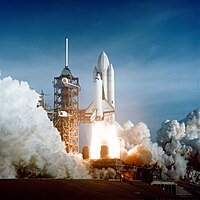
Despite refinements to the launcher's thermal protection system and other enhancements, Columbia would never weigh as little unloaded as the other orbiters in the fleet. The next-oldest shuttle, Challenger, was also relatively heavy, although 2,200 lb (1,000 kg) lighter than Columbia.
Externally, Columbia was the first orbiter in the fleet that originally had a mostly all-tile thermal protection system (TPS) with nomex Fiberous Reuseable Surface Insulation (FRSI) blankets in some areas on the wings and fuselage. This was later modified to incorporate thicker Advanced Fiberous Reuseable Insulation (AFRSI) blankets on the fuselage and upper wing surfaces as well after their successful use on shuttle Discovery and Atlantis. The work was performed during Columbia's first retrofitting and the post-ChallengerColumbia were the black "chines" on the upper surfaces of the shuttle's forward wing. These black areas were added because the first shuttle's designers did not know how reentry heating would affect the craft's upper wing surfaces. The "chines" allowed Columbia to be easily recognized at a distance, as opposed to the subsequent orbiters. stand-down. Also unique to
Until its last refit, Columbia was the only operational orbiter with wing markings consisting of an American flag on the port (left) wing and the letters "USA" on the starboard (right) wing. Challenger, Discovery, Atlantis, Endeavour, and even the Enterprise all, until 1998, bore markings consisting of the letters "USA" afore an American flag on the left wing, and the pre-1998 NASA "worm" logo afore the respective orbiter's name on the right wing. From its last refit to its destruction, Columbia bore markings identical to those of its operational sister orbiters — the NASA "meatball" logo on the left wing and the American flag afore the orbiter's name on the right; only Columbia's distinctive wing "chines" remained.
Another unique external feature, termed the "SILTS" pod, was located on the top of Columbia's tailfin, and was installed after STS-9 to acquire infrared and other thermal data. Though the pod's equipment was removed after initial tests, NASA decided to leave it in place, mainly to save costs, along with the agency's plans to use it for future experiments. The tailfin was later modified to incorporate the drag chute first used on Endeavour in 1992.
Columbia was originally fitted with Lockheed Martin-built ejection seats identical to those found on the SR-71 Blackbird. These seats were active for the four orbital test flights, but were deactivated after STS-4STS-9. Columbia was also the only orbiter not delivered with head-up displays for the Commander and Pilot, although these were incorporated after STS-9. Like its sister ships, Columbia was eventually retrofitted (at its last refit) with the new MEDS "glass cockpit" display and lightweight seats. and were removed entirely after
After the STS-118 mission, Columbia’s career would have started to wind down. The shuttle was planned to service the Hubble Space Telescope two more times, once in 2004, and again in 2005, but no more missions were planned for it again until 2009 when, on STS-144, it would retrieve the Hubble Space Telescope from orbit and bring it back to Earth. Following the Columbia accident, NASA flew the STS-125 mission, using the Atlantis to perform the final service mission (incorporating the planned fourth and fifth servicing missions), and in the process, installed a "Soft Capture Docking Mechanism," based on the docking adapter to be used on the Orion spacecraft, for an eventual atmospheric reentry and breakup, as this would occur after the retirement of the Space Shuttle fleet in 2010.
Columbia was also scheduled to launch the X-38 V-201 Crew Return Vehicle prototype as the next mission after STS-118, until the cancellation of the project in 2002.
[edit] Flights
Space Shuttle Columbia flew 28 flights, spent 300.74 days in space, completed 4,808 orbits, and flew 125,204,911 miles (201,497,772 km) in total, including its final mission.Columbia was the only shuttle to have been spaceworthy during the Shuttle-Mir and International Space Station programs and yet to have never visited either Mir or ISS. In contrast, Discovery, Atlantis, and Endeavour have all visited both stations at least once, as Columbia was not suited for high-inclination missions. Challenger was destroyed before the Shuttle-Mir Program began, and Enterprise never flew in space.
| # | Date | Designation | Launch pad | Landing location | Notes |
|---|---|---|---|---|---|
| 1 | 1981, April 12 | STS-1 | 39-A | Edwards Air Force Base | First shuttle mission. Launch witnessed by the band Rush; inspired the song "Countdown" on their 1982 album Signals. |
| 2 | 1981, November 12 | STS-2 | 39-A | Edwards Air Force Base | First re-use of manned space vehicle |
| 3 | 1982, March 22 | STS-3 | 39-A | White Sands Space Harbor | First mission with an unpainted External tank. Only time that a space shuttle has landed at the White Sands Space Harbor. This launch was dedicated by Ronald ReaganAfghanistan". to "the people of |
| 4 | 1982, June 27 | STS-4 | 39-A | Edwards Air Force Base | Last shuttle R&D flight |
| 5 | 1982, November 11 | STS-5 | 39-A | Edwards Air Force Base | First four-person crew, first deployment of commercial satellite. |
| 6 | 1983 November 28 | STS-9 | 39-A | Edwards Air Force Base | First six-person crew, first Spacelab. |
| 7 | 1986, January 12 | STS-61-C | 39-A | Edwards Air Force Base | Representative Bill Nelson (D-FL) on board/ final successful shuttle flight before Challenger disaster |
| 8 | 1989, August 8 | STS-28 | 39-B | Edwards Air Force Base | Launched KH-11 reconnaissance satellite |
| 9 | 1990, January 9 | STS-32 | 39-A | Edwards Air Force Base | Retrieved Long Duration Exposure Facility |
| 10 | 1990, December 2 | STS-35 | 39-B | Edwards Air Force Base | Carried multiple X-ray & UV telescopes |
| 11 | 1991, June 5 | STS-40 | 39-B | Edwards Air Force Base | 5th Spacelab - Life Sciences-1 |
| 12 | 1992, June 25 | STS-50 | 39-A | Kennedy Space Center | U.S. Microgravity Laboratory 1 (USML-1) |
| 13 | 1992, October 22 | STS-52 | 39-B | Kennedy Space Center | Deployed Laser Geodynamic Satellite II |
| 14 | 1993, April 26 | STS-55 | 39-A | Edwards Air Force Base | German Spacelab D-2 Microgravity Research |
| 15 | 1993, October 18 | STS-58 | 39-B | Edwards Air Force Base | Spacelab Life Sciences |
| 16 | 1994, March 4 | STS-62 | 39-B | Kennedy Space Center | United States Microgravity Payload-2 (USMP-2) |
| 17 | 1994, July 8 | STS-65 | 39-A | Kennedy Space Center | International Microgravity Laboratory (IML-2) |
| 18 | 1995, October 20 | STS-73 | 39-B | Kennedy Space Center | United States Microgravity Laboratory (USML-2) |
| 19 | 1996, February 22 | STS-75 | 39-B | Kennedy Space Center | Tethered Satellite System Reflight (TSS-1R) |
| 20 | 1996, June 20 | STS-78 | 39-B | Kennedy Space Center | Life and Microgravity Spacelab (LMS) |
| 21 | 1996, November 19 | STS-80 | 39-B | Kennedy Space Center | 3rd flight of Wake Shield Facility (WSF)/ longest Shuttle flight as of 2006 |
| 22 | 1997, April 4 | STS-83 | 39-A | Kennedy Space Center | Microgravity Science Laboratory (MSL)- cut short |
| 23 | 1997, July 1 | STS-94 | 39-A | Kennedy Space Center | Microgravity Science Laboratory (MSL)- reflight |
| 24 | 1997, November 19 | STS-87 | 39-B | Kennedy Space Center | United States Microgravity Payload (USMP-4) |
| 25 | 1998, April 13 | STS-90 | 39-B | Kennedy Space Center | Neurolab - Spacelab |
| 26 | 1999, July 23 | STS-93 | 39-B | Kennedy Space Center | Deployed Chandra X-ray Observatory |
| 27 | 2002, March 1 | STS-109 | 39-A | Kennedy Space Center | Hubble Space Telescope service mission (HSM-3B) |
| 28 | 2003, January 16 | STS-107 | 39-A | Did not land (Planned to land at Kennedy Space Center) | A multi-disciplinary microgravity and Earth science research mission. Shuttle destroyed during re-entry on February 1, 2003 and all seven astronauts on board died. |
[edit] Mission insignias
| Mission insignia for Columbia flights | |||||||
|---|---|---|---|---|---|---|---|
| | | | | | | | |
| | | | | | | | |
| | | | | | | | |
| | | | | | | | |
| | | | | | | | |
| | | | | | | | |
| | | | | ||||
| | | | | ||||
[edit] Final mission and destruction
[edit] Tribute
The shuttle's final crew was honored in 2003 when the USGS's Board of Geographic Names approved the name Columbia Point for a 13,980-foot mountain in Colorado's Sangre de Cristo Mountains, less than a half-mile from Challenger Point, a peak named for America's other lost shuttle. The Columbia Hills on Marsother memorials were dedicated in various forms. were also named in honor of the crew, and a host ofFans of the original Star Trek television series were largely responsible for NASA naming the first Space Shuttle Enterprise. In the television series Star Trek: Enterprise both the first and second starships of the human-built NX-Class, registry numbers NX-01 & NX-02 respectively, were named in honor of pre-existing NASA space shuttles. The second vessel's name was first revealed in the season 3 episode "E²" to be Columbia, in honor of the space shuttle Columbia following its destruction on February 1, 2003. Uniforms on NX-02 Columbia bear a crew patch depicting 7 stars, in honor of the astronauts who died in the shuttle accident.
[edit] See also
| Wikimedia Commons has media related to: Space Shuttle Columbia |









